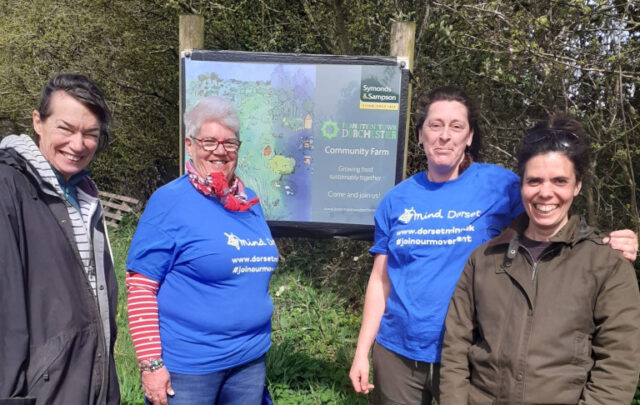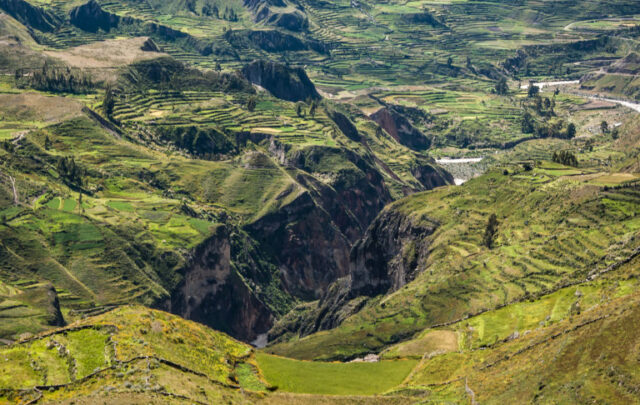
 Harvesting the Sonoran Desert
Harvesting the Sonoran DesertOn a stretch of desert near the U.S.-Mexico border, the only eatery on the Tohono O’odham Indian Reservation opened last spring to a full house.
The Desert Rain Café brightened a space in a small shopping complex, drawing dozens of curious customers who filled patio tables by noon. Its menu, local by design, featured ingredients from the café’s own farm: desert squash enchiladas, mesquite-flour muffins, hummus made from tepary beans. The café recently extended its hours to take advantage of its booming business.
But the Desert Rain is more than an earnest new venture in a sleepy desert outpost. The café and its reliance on native foods is part of a community solution to a community problem: diabetes and obesity.
Members of the Tohono O’odham Nation, whose sprawling reservation begins southwest of Tucson, Arizona, and extends into Mexico, suffer from one of the highest type 2 diabetes rates ever recorded.
“The concept here is not if I get diabetes, but when I get it,” explains Christina Andrews. She estimates that, during her tenure as executive director of the Department of Human Services (the tribe’s health department), 80 percent of patients were diabetic. “When you see all of your relatives die from the disease, it begins to seem inevitable.”

Around the country, diabetes is ravaging native communities. Amer ican Indians and Alaskan Natives are more than twice as likely to have diabetes than whites, and three times as likely to die from the disease. The death rate among the Tohono O’odham (pronounced “autumn”) is even higher—twice that of other American Indian tribes.
But O’odham members have launched their own programs in an effort to reverse that trend. A new kidney-dialysis center has opened next to the tribal headquarters, and a grassroots organization, Tohono O’odham Community Action (TOCA), with its café and farm, has turned to traditional foods to solve a modern problem.
The land of the O’odham is breathtaking. The 60-mile drive from Tucson to Sells, the sleepy town at the tribe’s center, passes through terrain filled with saguaro cactus, ocotillo, and mesquite. The Baboquivari Mountains—sacred to the O’odham—unfold on the left, eventually descending into vast floodplains.
The tribe has 13,000 members living in about 70 villages across the Sonoran Desert. Abandoned houses are abundant, and many of the buildings are tagged with gang graffiti. Signs of poverty are everywhere: The annual median income of the O’odham is about $23,000, lower than the $31,600 median income for Native Americans nationwide.
What might look like impossibly dry land used to sustain the O’odham; they cultivated drought-resistant crops and diverted flash floods from summer monsoons onto their fields. But when the summer rains didn’t fall, the food supply tightened, and eventually, the scientific theory goes, “thrifty” genes developed.
Efficient genes could help explain why the O’odham are so vulnerable to diabetes. “There is usually a genetic component to obesity and diabetes,” says Joan Chamberlain of the National Institutes of Health. “These same genes that allowed people to live frugally and survive famines aren’t prepared for the massive abundance of calories and fat.”
The average weight of O’odham men in 1938, for example, was 158 pounds. By 1978, the average weight had increased to 202. According to Dr. Peter Ziegler, clinical director for the Indian Health Service (IHS) in Sells, more than half of O’odham women ages 35 and older are diabetic, with slightly lower rates for men (along with a potentially sizable percentage of people still undiagnosed).
Perhaps the most dispiriting trend is how diabetes and obesity are affecting ever-younger individuals. A 4-year-old O’odham was diagnosed with type 2 diabetes, and at the IHS unit in Sells, nearly half of the child patients are obese, with another 20 percent considered overweight.
“All O’odham are big people,” Andrews says. “Everyone in my family is big.”
Historically, the Tohono O’odham were slender and athletic. People ran between villages to share news or simply visit. For recreation, races between villages were organized. And in order to survive in the arid terrain (Tohono O’odham means “Desert People”), they spent much of their time gathering food—from the fruit pods of the saguaro cactus to the mesquite beans that would be ground into flour.
“We’re living in a very different time period,” said Danny Lopez, a tribal elder who was born in 1936 and taught the O’odham language and history at the local community college. Lopez, who passed away in 2008, served as a link to traditional O’odham ways, teaching the youth songs and storytelling, and stressing the importance of speaking the language. “Can you believe when I was growing up,” he said, “we didn’t even have a word for diabetes?”
In 1996, Terrol Dew Johnson, a tribal member and award-winning basket-weaver, was teaching weaving classes in Sells when he met Tristan Reader, a former tenant organizer in Boston. Reader had started a community garden on the grounds of a reservation church where his wife had been hired as a pastor. Johnson and Reader got to talking about the many challenges facing the O’odham—a lack of activities for teens, high unemployment, the diminishing knowledge of O’odham culture and history—and decided to hold a six-week arts and culture program for at-risk youth.
Later that year, Johnson and Reader founded TOCA and spent the first several years developing its youth and culture programs.
With the input of elders like Lopez, the organization began learning more about the tribe’s history—just how drastically the O’odham diet and lifestyle had changed in recent decades, and how this change was tied to the destruction of traditional farming. TOCA took an activist approach: What could it do, today? How could it change people’s behaviors?
“We have to remember that in the last 60 years there wasn’t some dramatic change in genetic makeup,” Reader said. “It’s the diet that has changed. And blaming everything on genes can disempower people and make them feel they can’t do anything about it.”
Reader pointed to an ongoing, $100 million genetic research project conducted by the National Institutes of Health on the Pima Indians—who are related ancestrally to the O’odham and suffer a similar diabetes rate. A previous study compared the diabetes rates of the Pima in Mexico—who still farm and adhere to a traditional diet—with the Pima of Arizona. The Pima in Mexico had a diabetes rate less than one-fifth that of their U.S. kin.
TOCA’s task was to find a way to tackle the diabetes crisis in a way that resonated with the O’odham community and drew upon O’odham culture. In 2000, when Johnson’s grand father passed away from complications related to diabetes, TOCA leaders had an idea.
Traditionally, the staple of the O’odham diet was the tepary bean, which needs little water to grow and is low on the glycemic index (which measures how fast the body converts carbohydrates to glucose), a factor that may aid in controlling diabetes. The O’odham also cultivated drought- resistant crops like 60-day corn and squash.
Nutritional research has shown that foods of the desert, like the tepary bean and mesquite flour, played a key role in regulating blood-sugar levels and slowing sugar-absorption rates, being low in fats and simple sugars but high in soluble fiber and complex carbohydrates.
It is estimated that in 1930 the tribe grew 1.6 million pounds of tepary beans on the reservation for their consumption; by 2000, that amount had shriveled to less than 100 pounds. A number of factors contributed to the dramatic decline in the O’odham’s food production. As the city of Tucson grew after World War II, it needed water, and deep wells were dug along the reservation’s boundaries. The aquifers dropped, reducing river flooding and runoff needed for irrigation. The Bureau of Indian Affairs (BIA) contributed to the decline in subsistence farming by moving Indians into jobs as cotton workers off the reservation as a means of assimilation.
The destruction of the O’odham food system wasn’t only about food, it was about culture—exchanging an active lifestyle and local diet for an existence reliant on paychecks and government commodities, mostly processed foods high in starch and sugars. Millennia of food independence became dependence in a matter of decades.
“They came here to civilize and educate us,” Lopez, the tribal elder, said, his delivery characteristically dry and deadpan. Lopez was shipped to a BIA boarding school in Phoenix for two years as a youngster, and his family was recruited to work in the cotton fields north of the reservation. At one time, his village, appropriately called Big Fields, included 1,100 acres of cultivated crops. Today, the fields lie fallow.

Johnson’s grandfather farmed a small field in a village near Sells until the 1970s. After the passing of his grandfather, Johnson says, “We thought, why not plant traditional crops on it as a way to pay homage to him?” The 37-year-old Johnson, like his parents and two siblings, is diabetic. After locating the field with the help of his grandmother—the area had become overgrown with mesquite— TOCA cleared it and planted tepary beans, with seeds provided by a Tucson-based seed bank, Native Seeds/SEARCH. At the time, there was only one person on the entire reservation still growing traditional crops.
Several years later, with financial support primarily from the First Nations Development Institute and the Kellogg Foundation, TOCA leased land on an old tribal farm close to the border with Mexico and later purchased a combine, helping spur production. “If we wanted this to be more than a novelty, then we had to increase the scale,” explained Reader.
Today, Johnson’s older brother, Nolan, is in charge of both the 125-acre farm near the border and his grand father’s original plot of land. This year TOCA will harvest 50 tons of squash and melon, 45 tons of tepary beans, and 10 tons of 60-day corn, all of which ends up at the grocery store, at tribal festivals, and in patient meals at the IHS hospital. TOCA hopes to partner with schools on the reservation and serve traditional foods to students.
“At school, most of the kids are eating two free meals a day through federal programs, heat-and-serve stuff from Sysco,” said Reader. “So it doesn’t make a whole lot of sense to tell people to eat right, and then give kids who are prone to diabetes a breakfast of waffles and maple syrup. We need a complete systems change.”
With production developing rapidly, TOCA’s next task is to overcome the same barriers to healthy eating that poor people face across the country. Unhealthy food is inexpensive and quick.
Each year, TOCA gives away 2,500 pounds of tepary beans, and expanded production has allowed it to drop prices. Two years ago, for instance, tepary beans sold for $3 a pound; a customer can now buy a pound for $1.75.

A second barrier to eating traditional foods, identified through a 2002 survey of residents, is preparation. “If it takes four hours to cook the beans, and you’re working all day, what are you going to do?” asked Reader. “We need to make it convenient.” The Desert Rain Café, in the same shopping complex as the grocery store, is one way to address the problem.
TOCA’s message: When respected and cultivated, the land considered sacred to the O’odham created healthy O’odham. TOCA pushes this message to the younger generation, planting school gardens, and organizing traditional outings to gather the saguaro fruit and other native plants.
“We meet with kids and ask them about traditional O’odham foods,” said Johnson. “And they start talking about things like fry bread.” Fry bread is made from flour, salt, and lard; Indians adopted the unhealthy concoction with the introduction of government commodities. “We have to re-educate people and tell them that fry bread isn’t an O’odham tradition. We need to go back even further.”
TOCA members know that the destruction of O’odham culture can’t be reversed quickly with a new pill or program: That’s the Western way, the model of hollow promises and quick fixes. After a century of adopting the prescriptions of others, the results have been disastrous. New innovations may have their place, but nothing can substitute for historical memory.
Gabriel Thompson wrote this article for Learn as You Go, the Fall 2009 issue of YES! Magazine. Gabriel is the author of There’s No José Here: Following the Hidden Lives of Mexican Immigrants and Calling All Radicals: How Grassroots Organizers Can Save Our Democracy.





